The most eagerly awaited iPhone since the last one, the Apple’s iPhone 7 has arrived. Much has been said about its design, the absent headphone socket, and the fact that it’s now waterproof, but is it actually any good?
Following on from the iPhone 6 was a tall order, which the iPhone 6S struggled to live up to, with fewer sales and less consumer enthusiasm. Two years on, the question is whether those iPhone 6 buyers will bite and upgrade to the most expensive iPhone yet, its price in the UK inflated thanks to the Brexit referendum result.
The same but now waterproof

On the outside the iPhone 7 (find here) is so similar to the iPhone 6 and 6S you might think nothing has changed other than a new paint job: it’s now available in black and a shiny jet black, as well as rose gold, gold and silver from last year, but no space grey .
The antenna lines – the plastic inlays into the metal body – are slightly less visible on the back having been shunted to the top, the glass front is the same, with the most obvious change being the lack of a 3.5mm headphone socket in the bottom.
It’s a tried and trusted, but ageing design. While other manufacturers have shrunk the bezels around their screens and generally made the display more of the front of the phone, the iPhone has stayed static. That doesn’t mean the build quality or fit and finish is anything other than excellent, but others including Samsung have similar manufacturing prowess.
The 4.7in iPhone 7 is 7.1mm thick and 138g (5g lighter than the iPhone 6S), while rival the 5.1in Samsung Galaxy S7 is 7.9mm thick and weighs 152g and Huawei’s 5in P9 is 7mm thick and weighs 144g.
The iPhone 7 is now waterproof to IP67 standards, which means up to 1m deep in fresh water for up to 30 minutes. In comparison, Samsung’s Galaxy S7 is rated to IP68 standards, which are at least 1.5m deep for at least 30 minutes. It means that while going swimming with the iPhone 7 isn’t recommended, it will survive a drop into the washing up bowl or down the toilet. And you can wash it.
The screen’s colour and brightness is excellent for an LCD. It isn’t quite as vibrant with deep inky blacks as some high-end OLED screens fitted to Samsung devices, neither is it as pixel dense as all Apple’s rivals or even the iPhone 7 Plus, meaning it isn’t as pin-sharp and you can see the individual pixels. It is better than last year’s model and feels as good as LCD can get.
The 4.7in screen is also quite small for today’s smartphones and makes some things a bit fiddly on poorly optimised websites. Not anywhere near as fiddly as the 4in iPhone SE of course. The small size also means that it’s relatively easy to keep hold of compared to the big-screen phablets with displays over 5.5in.
New for this year is a pair of stereo speakers, one of which is the front-facing earpiece loudspeaker, the other the bottom-firing speaker from previous models. Together they are louder, but lack any sort of stereo separation and couldn’t be described as room-filling.

Specifications
- Screen: 4.7in 1334x750 (326ppi)
- Processor: Apple A10 Fusion
- RAM: 2GB of RAM
- Storage: 32/128/256GB
- Operating system: iOS 10
- Camera: 12MP rear camera, 7MP front-facing camera
- Connectivity: LTE, Wi-Fiac, NFC, IR, Bluetooth 4.2, Lightning and GPS
- Dimensions: 138.3 x 67.1 x 7.1mm
- Weight: 138g
Snappy performance
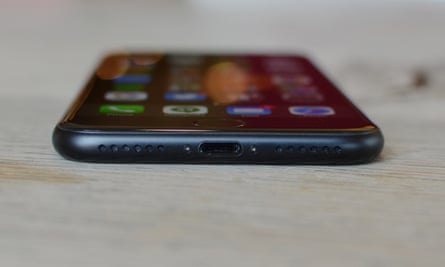
The iPhone 7 has Apple’s latest processor the A10 Fusion, which, like most processors used in Android smartphones, has four processing cores split into two pairs. One is a high-performance pair of cores the other is a pair of energy efficient cores.
When the user does something demanding, such as 3D gaming, photo processing or similar, the two big cores fire up, but when just chewing through email or sending a text the two power efficient cores run the show. The idea is that most of the time only the more power efficient cores are required, which helps extend battery life but doesn’t sacrifice performance.
The iPhone 7 is snappy, feeling slightly faster than the iPhone 6S in general use. Some things, such as photo processing, particularly in something like Prisma, are also faster. It chews through games without issue and is capable of dealing with pretty much everything you could throw at it. iOS 10 also feels faster, with more quick actions, which helps the phone feel faster.
Battery anxiety
Battery life, however, is poor. Using it as my primary device with three hours of app usage and browsing, hundreds of emails and push notifications, a couple of photos, five hours of music over Bluetooth headphones and the odd game of Jetpack Joyride during my one hour and 20 minute train commute to and from work, it lasted an average of just over 14 hours between charges, meaning it didn’t survive past 9.30pm.
Rather than having better battery life in my testing, the iPhone 7 has worse battery life than the iPhone 6S when new. No single app caused significant battery drain, I do not have the Facebook app installed and Low Power Mode made no appreciable difference in my testing when enabled at 20%.
If I had needed it to navigate me home or snap some pictures at night I would have to make sure I did a good charge before leaving the office. If I used it for maps for any walking or driving, battery life was much shorter. To get through 24 hours, you’ll be forced to have a power adapter close by, shove it in a battery pack or charge at your desk, which means you won’t be able listen to music at the same time via cabled headphones – more on that later.
To make matters worse, the iPhone 7 has the worst of all worlds: short battery life and tediously slow charging. Even using the 12W charger that came with the iPad Pro it took well over two hours to fully charge the iPhone 7.
iOS 10
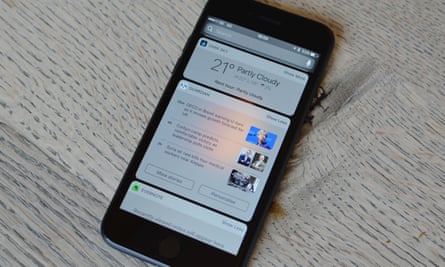
Every year Apple releases a new version of iOS for its newest iPhone and older models. This year’s iOS 10 makes some significant changes to the usability of the software, modernising its approach to notifications, which have become the lifeblood of our increasingly connected world. It follows the approach taken by Google’s Android.
Notifications are now rich, with previews and quick replies, speeding up the whole experience. Tap to launch the app, press to pop up a quick preview or widget with options to reply, delete or similar. You can also clear all notifications by pressing on the clear button, rather than be limited to clearing a day at a time.
Widgets are now a much bigger thing on the iPhone. The left-most pane on the home screen or the lockscreen now shows a bunch of widgets that were confined to the pull down shade before. While many of them feel superfluous it’s worth curating them to create an at-a-glance screen full of information like the current weather conditions, your next appointment, whether your commute is going to be a nightmare, that kind of thing.
Widgets also show up when you force press on an icon of certain apps, along with a load of quick settings. They’re still available in the pull-down shade too.
While most of the changes have made the software experience faster, the two-pane Control Centre does not. You have to swipe between quick settings and music controls, which were combined on one pane in iOS 9.
It remembers which pane you last used, but isn’t smart enough to go back to quick settings when you’re not playing music. Also, while you can press on the torch icon to change the intensity of the beam, you can’t do the same for Wi-Fi, Bluetooth or Do not disturb. You can’t even get to the Settings app from Control Centre. You have to bounce back to the home screen and launch the app.
iOS is now starting to look and feel a bit dated compared with what Google is doing with Android, which is a bit of a role reversal for the two companies. But if you liked iOS on pretty much any other iPhone before, you’ll love this, because it’s the same just with 3D touch functions if you’re upgrading from something older than an iPhone 6S.
Touch ID, Home button and Taptic Engine
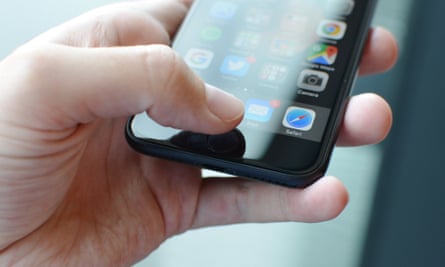
The fingerprint scanner is the same as that fitted to the iPhone 6S and is fast and accurate, although not quite the best in the industry. The home button, however, has changed.
Instead of being a real button it’s now a pressure sensitive pad. It doesn’t depress, but you have to push it rather than tap it to activate it as a home button. In response to your pressure there’s a little haptic feedback, which is more taping than vibration.
It doesn’t feel anything like pressing the old home button, more like pressing the mouse button on a Magic Mouse or Apple’s Magic Trackpad; it feels like the whole end of the phone depresses.
Apple first used the technology in its MacBook laptop for the solid-state trackpad. It didn’t move but the little Taptic Engine made it feel like it did. The home button isn’t anywhere near as good a replication of the original home button’s feel. Some will love it, some will hate it, most will just get on with it.
The Taptic Engine as a whole, for notifications and general feedback, such as the little taps as you scroll through the timer’s wheel like notches on something mechanical, is excellent. It is genuinely the best thing Apple has created in years.
Camera
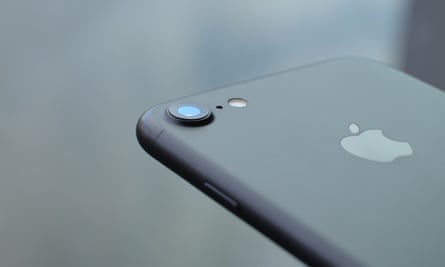
The iPhone 7’s camera is greatly improved over the iPhone 6S. It has a much faster, brighter f/1.8 lens, optical image stabilisation and takes photos that are a lot sharper even for shaking hands.
Images produced in good light are fairly detailed, but can often be a bit dull and washed out while not being quite pin-sharp in some areas losing fine detail in the process. Low-light performance is much improved over the iPhone 6 and 6S, while no fancy software is needed to create pleasing bokeh effects as a shallow depth of field is a function of the f/1.8 lens. The rear camera is one of the best available, but not quite the best, outperformed on fine detail by Samsung’s Galaxy S7 series.
The front-facing 7-megapixel selfie camera is one of the best in the business, creating detail rich and colour accurate photos even under difficult artificial lightning conditions.
Headphone jack
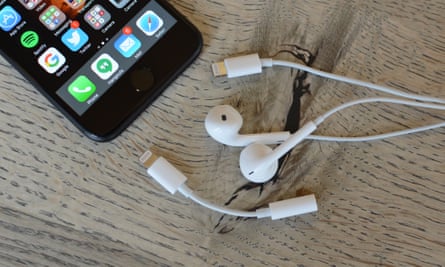
The iPhone 7 will be remembered for Apple killing the headphone jack. Straight up: the removal of the 3.5mm headphone socket is not a good thing. It makes it harder to use the phone with conventional headphones and it seems unnecessary.
How much the loss will affect you depends on what you use to listen to music on your smartphone. If it’s just Apple’s EarPods - which have absolutely no isolation and are pretty average on sound quality - then you won’t notice when listening to your phone. The Lightning socket works fine, the only problem is the cable doesn’t twist, so I ended up with twisting cords and you can’t charge and listen to your iPhone 7, say at your desk in an open-plan office.
The problem comes when you try to plug the new EarPods included in the box into anything else, because you can’t. Your computer doesn’t have a Lightning socket, neither does your stereo, your TV or Game Boy, which may have found a new spot in your life post Pokémon Go.
Instead you can forget the Lightning EarPods and use a Lightning to 3.5mm adapter - one is included in the box - for your normal, analogue headphones. If they have an iPhone-compatible in-line controller, volume and pause/play commands are passed through using the adapter.
The Lighting-to-3.5mm has a digital-to-analogue converter embedded in it, which makes your headphones reliant on Apple’s cheapest accessory costing £9, thankfully it sounds decent, if a little heavier on the bass than the headphone socket on the iPhone 6S.
Better is to go Bluetooth. I cut the cable about five years ago and haven’t looked back. Most Bluetooth headphones come with an optional 3.5mm cable, so you can plug them into your computer easily and just rely on Bluetooth for the phone.
Bluetooth earbuds, however, are a more difficult proposition. There are some decent ones with a small cable linking the pair, but completely wireless earbuds are a bit hit and miss. Most struggle to maintain a connection between your ears. Hopefully that’ll be solved in the near future. Apple has a set planned, but the AirPods are essentially EarPods without the cable and so will likely have the same acoustic characteristics.
You can record audio using a phone mic or pickup plugged into the Lightning to 3.5mm adapter, but for some you’ll end up with two adapters plugged into each other just to record audio.
Observations

- The matt black colour looks good but appears a bit like plastic until you touch it
- The matt metal body is pretty slippery to hold, but doesn’t slide off tables
- The home button needs skin contact to work, rendering sport armbands and some touchscreen gloves useless
- You can’t unlock the phone without first activating the Home button
- Bluetooth performance is better, holding a more stable connection with less interference with relatively weak devices such as wireless earbuds than the iPhone 6S and some competitors
- With the antenna lines the most hidden and the screen black when off, the matt black colour is the best-looking
- The jet black glossy finish scratches relatively easy, so to keep it looking like new you’ll need a case
- The new antenna bands trap fluff in them, which is very difficult to remove
Price
The iPhone 7 costs £599 for 32GB (buy here), £699 for 128GB (buy here) or £799 for 256GB in rose gold, gold, silver, black or jet black (buy here).
For comparison, the HTC 10 costs £570, the 32GB Samsung Galaxy S7 costs £500, the LG G5 costs £500, the 32GB Huawei P9 costs £449, the 16GB iPhone SE costs £359 and last year’s iPhone 6S cost £539 now £499 for 32GB of storage.
Verdict
The iPhone 7 is a missed opportunity. Apart from a bit of fluff retention the fit and finish, the cameras, fingerprint scanner, snappy performance and waterproofing are all great. But what does it matter how good it is when the battery is dead?
The battery life just isn’t good enough to last one day, let alone two when so many other smartphones do. And when the iPhone 7 is dead it takes ages to charge it up again. It’s really poor.
Then there’s the headphone jack, which wasn’t really an issue for me having adopted Bluetooth headphones years ago. But it is a pain in the neck if you attempt to use the Lightning EarPods and ever connect your headphones to anything else other than the iPhone or an iPad, or you lose that stupid little Lightning adapter dongle. Oh and you can’t charge and listen to music via cable.
Is this the best iPhone? Probably. Should you buy it? Not if you care about battery life. At the end of the day, this is the iPhone you’ll probably end up buying, but not the one you deserve.
Pros: waterproof, great cameras, good fingerprint scanner, premium build, good in-hand feel, Taptic Engine
Cons: no headphones port, cannot unlock the phone with gloves or within an armband case, expensive, no removable battery, no memory expansion, can’t charge and listen to cabled headphones, poor battery life, slow charging
Other reviews
- OnePlus 3 review: flagship phone at mid-range price
- Honor 8 review: Huawei’s cheaper smartphone is just short of brilliant
- HTC 10 review: up there with Samsung’s best
- Huawei P9 review: aiming for the big boys but just missing on software
- LG G5 review: a power user’s friend that just misses the mark
This article contains affiliate links to products. Our journalism is independent and is never written to promote these products although we may earn a small commission if a reader makes a purchase.
